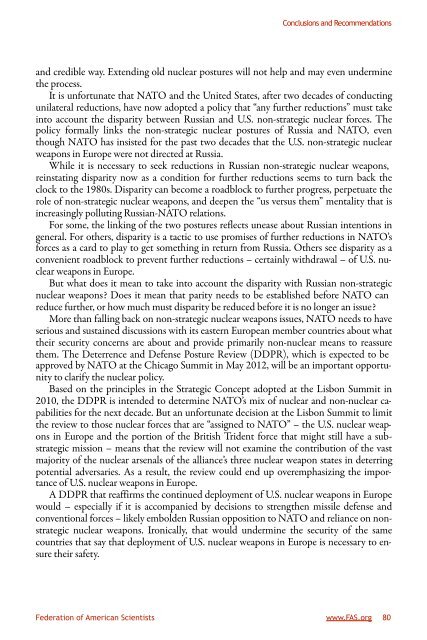Non Strategic Nuclear Weapons - Federation of American Scientists
Non Strategic Nuclear Weapons - Federation of American Scientists
Non Strategic Nuclear Weapons - Federation of American Scientists
You also want an ePaper? Increase the reach of your titles
YUMPU automatically turns print PDFs into web optimized ePapers that Google loves.
Conclusions and Recommendations<br />
and credible way. Extending old nuclear postures will not help and may even undermine<br />
the process.<br />
It is unfortunate that NATO and the United States, after two decades <strong>of</strong> conducting<br />
unilateral reductions, have now adopted a policy that “any further reductions” must take<br />
into account the disparity between Russian and U.S. non-strategic nuclear forces. The<br />
policy formally links the non-strategic nuclear postures <strong>of</strong> Russia and NATO, even<br />
though NATO has insisted for the past two decades that the U.S. non-strategic nuclear<br />
weapons in Europe were not directed at Russia.<br />
While it is necessary to seek reductions in Russian non-strategic nuclear weapons,<br />
reinstating disparity now as a condition for further reductions seems to turn back the<br />
clock to the 1980s. Disparity can become a roadblock to further progress, perpetuate the<br />
role <strong>of</strong> non-strategic nuclear weapons, and deepen the “us versus them” mentality that is<br />
increasingly polluting Russian-NATO relations.<br />
For some, the linking <strong>of</strong> the two postures reflects unease about Russian intentions in<br />
general. For others, disparity is a tactic to use promises <strong>of</strong> further reductions in NATO’s<br />
forces as a card to play to get something in return from Russia. Others see disparity as a<br />
convenient roadblock to prevent further reductions – certainly withdrawal – <strong>of</strong> U.S. nuclear<br />
weapons in Europe.<br />
But what does it mean to take into account the disparity with Russian non-strategic<br />
nuclear weapons? Does it mean that parity needs to be established before NATO can<br />
reduce further, or how much must disparity be reduced before it is no longer an issue?<br />
More than falling back on non-strategic nuclear weapons issues, NATO needs to have<br />
serious and sustained discussions with its eastern European member countries about what<br />
their security concerns are about and provide primarily non-nuclear means to reassure<br />
them. The Deterrence and Defense Posture Review (DDPR), which is expected to be<br />
approved by NATO at the Chicago Summit in May 2012, will be an important opportunity<br />
to clarify the nuclear policy.<br />
Based on the principles in the <strong>Strategic</strong> Concept adopted at the Lisbon Summit in<br />
2010, the DDPR is intended to determine NATO’s mix <strong>of</strong> nuclear and non-nuclear capabilities<br />
for the next decade. But an unfortunate decision at the Lisbon Summit to limit<br />
the review to those nuclear forces that are “assigned to NATO” – the U.S. nuclear weapons<br />
in Europe and the portion <strong>of</strong> the British Trident force that might still have a substrategic<br />
mission – means that the review will not examine the contribution <strong>of</strong> the vast<br />
majority <strong>of</strong> the nuclear arsenals <strong>of</strong> the alliance’s three nuclear weapon states in deterring<br />
potential adversaries. As a result, the review could end up overemphasizing the importance<br />
<strong>of</strong> U.S. nuclear weapons in Europe.<br />
A DDPR that reaffirms the continued deployment <strong>of</strong> U.S. nuclear weapons in Europe<br />
would – especially if it is accompanied by decisions to strengthen missile defense and<br />
conventional forces – likely embolden Russian opposition to NATO and reliance on nonstrategic<br />
nuclear weapons. Ironically, that would undermine the security <strong>of</strong> the same<br />
countries that say that deployment <strong>of</strong> U.S. nuclear weapons in Europe is necessary to ensure<br />
their safety.<br />
<strong>Federation</strong> <strong>of</strong> <strong>American</strong> <strong>Scientists</strong> www.FAS.org 80
















